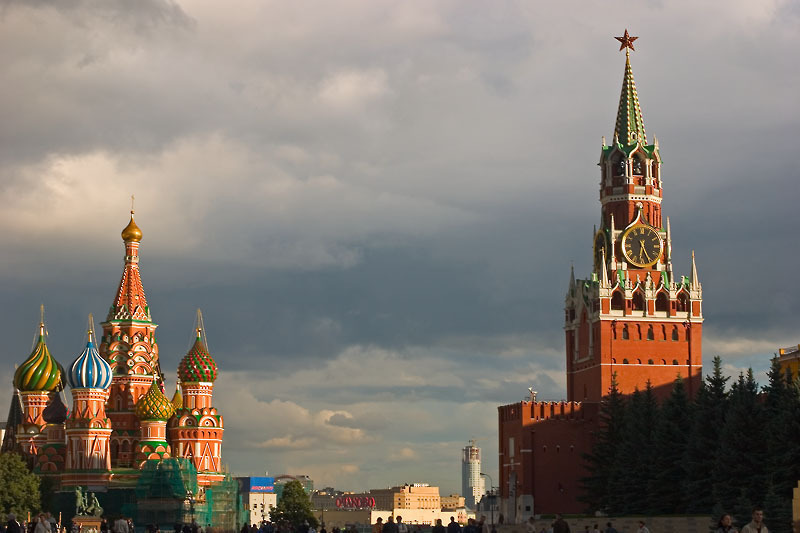 St. Basil's Cathedral and Spasskaya Tower from the Red Square in Moscow. Image Courtesy of Dmitry Azovtsev via Wikimedia Commons.
St. Basil's Cathedral and Spasskaya Tower from the Red Square in Moscow. Image Courtesy of Dmitry Azovtsev via Wikimedia Commons.
Russia’s Hybrid Power Strategy
Many Western states subscribe to classic black-and-white soft and hard power interpretations. Russia, however, is employing a strategy of “hybrid” power that blends these two forms. Russia’s strategy enables a target state to employ the coercive effects of hard power that it receives in the form of military aid and economic resources from Russia, and as a result, this creates a soft power attraction for Russian influence and resources that draws in other states. The targets for Russia’s hybrid power strategy are either unaligned states or states leaning away from the West. This includes developing weak states ruled by autocratic leaders and emerging powers with democratically elected leaders, such as India and Brazil. This hybrid power is now one of Russia’s only means of spreading influence as it compensates for and copes with diplomatic isolation and international condemnation following its invasion of Ukraine.
Russia’s hybrid power strategy primarily targets weak states with autocratic leaders. An autocratic leader of a weak state clinging to power will welcome the hard power that Russian military aid enables. When successful, this newly acquired hard power helps the weak state leader cement control and put down any opposition. In turn, the leader is more inclined to align with Russia on economic investment and international geopolitical affairs. However, the most valuable part for Russia is the attractive force generated by the weak states’ newly acquired hard power resources. This attractive force is the soft power part of the hybrid power strategy. A desire to align closer with Russia spreads amongst autocratic leaders in weak states. A bloc of countries beholden to Russia forms as military aid is sought by more countries. This is occurring in Africa where countries such as Mali, Burkina Faso, the Central African Republic, and Sudan—all of whom have struggled with coups and civil unrest—are increasingly welcoming Wagner Group forces and Russian military aid. As Russia continues to aid these countries militarily, its reputation as an ally to regimes will spread and further develop the bloc of countries.
Another way that Russia exports its military aid in return for soft power is by supplying militaries that rely on stockpiles of Soviet-era hardware that are incompatible with Western technology. Purchases of newer, compatible Russian arms and technology are attractive even for states close to the West because of their affordability compared to a complete military overhaul. Once Russia has its military aid hooks embedded, continued lucrative contacts can keep states reliant on Russian hardware. Russia particularly targets non-NATO, former Soviet states in Eastern Europe and Central Asia as Moscow strives to maintain its sphere of influence in the regions. Indeed, the heads of state of all five Central Asian countries, Armenia, and Belarus, attended Moscow’s 9 May military parade, sitting side-by-side with Putin.
Russia’s hybrid power strategy employs military aid heavily, but economic power is also a key factor for crafting attractive Russian influence. The BRICS organization facilitates close economic relations with Brazil, Russia, India, China, and South Africa, all emerging economies with global political implications. Through this organization, Russia can skirt sanctions from its war in Ukraine and maintain critical economic relations with the member states; sell oil to India, trade fertilizer for Brazilian beef, source minerals and critical elements from South Africa, and look to China for a SWIFT replacement. Instead of distancing themselves from Russia, the BRICS states have continued to work closely with Moscow, indicating the level of power (or, at the very least, respect) that Russia enjoys amongst its peers. If Russia can maintain and grow its level of influence within BRICS, it will continue to build its soft power between the member states.
Collective soft power and good relations between the BRICS states can quickly evolve into economic hard power, as seen with the New Development Bank (NDB). Russia’s hybrid power strategy is reversed in this case as the economic hard power comes from loans doled out to developing states by the NDB, and the soft power comes from the successful result of the loans. If a developing country benefits from a loan, the attractiveness of NDB loans, and business with BRICS, increases. This version of Russia’s hybrid power strategy, via BRICS and the NDB, targets governments of developing states that desire development loans with no strings requiring democratizing efforts attached, as many international financial institutions require. Through these loans, Russia and the other BRICS states gain direct economic influence into a country, increasing the collective soft power enjoyed by Russia and the other member states.
For the West to combat this area of Russian power, it must understand that soft power to Russia is not the same kind that the U.S. enjoys through Hollywood—Russian hybrid power targets with intention and malice. The effect Russia desires is to strengthen states that it can use in an opposition bloc and demonstrate to similar states that Russian military and economic resources are the best, or only, option available. The West will struggle to counter Russia’s hybrid power because each plays by its own rules in this realm. One method of taking on Russian hybrid power is creating attractive alternatives for states while clearly outlining the damage that awaits when dealing with Russia. The West should expect that some states may fall under Russian influence. Understanding this, the West should not be discouraged in its international development efforts. Each state targeted by Russian hybrid power is responsible for determining its own destiny, but the West must still strive to communicate effectively, and, cognizant of the reasons why Russia’s offers can be attractive, offer alternative options to prevent losing the developing world.
Photo Licensed under Creative Commons Attribution-Share Alike 3.0 Unported license.





